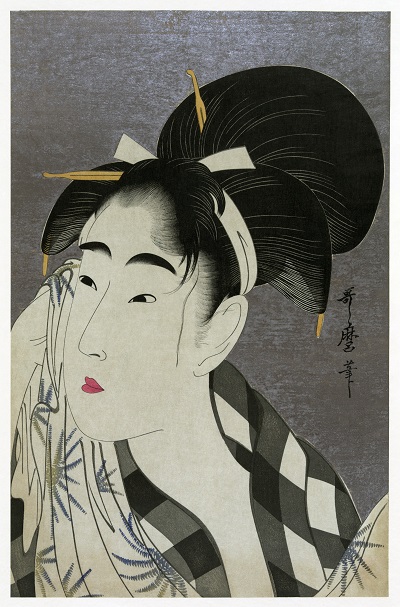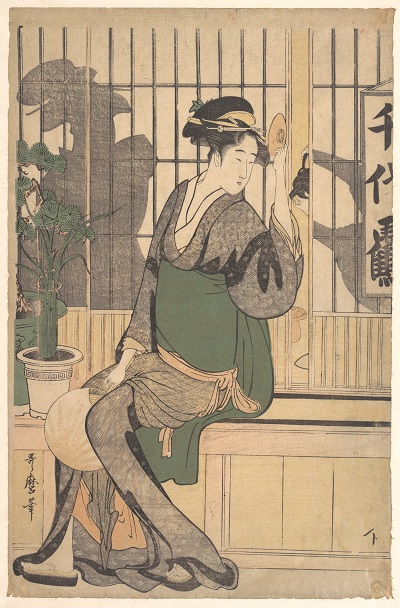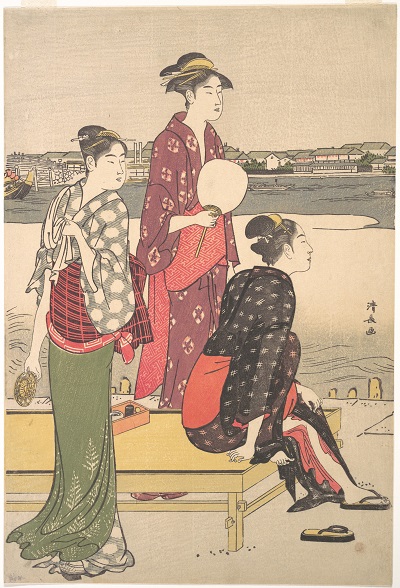This post is a selection of images of the Ukiyo-e art of Japan in the “Edo” period (1603-1868), The period is characterised as a time of economic growth, strict social order, peace, stable population and development of middle class arts and culture. The Ukiyo-e was a central part of that culture and the images reveal the life of the affluent and not so affluent people of Edo (Edo is now Tokyo).
The images below can be expanded and scroll viewed. This helps bring out the hidden beauty in the women. Use the scroll view function to watch details difficult to see with normal viewing. Just click the images. The images will expand and scroll view automatically. Within the scroll view, click control tabs on the upper left corner to fast scroll (skip button), expand, minimize, shift right or left, pause or scroll up or down.
The Ukiyo-e of “Kitagawa Utamaro”
Kitagawa Utamaro (1754–1806) was a master Ukiyo-e artist. One of the celebrated Ukiyo-e artists of the Edo period. He was particularly famous for his rendition of beautiful women from the waist up known as “bijin ōkubi-e”. He succeeded in capturing the different aspects of personality and transient moods of women of all classes, ages, and circumstances. Utamaro also had another side. He was famous for his painstakingly illustrated books on insects, These showed his marvellous drawing ability and meticulous attention to detail.




Numbered from left to right.
- “Yoshiwara Women Looking into the Street at Springtime“. Between 1753 and 1806. Yoshiwara was a well known red-light district in Tokyo Japan, one of three licensed districts created during the early 17th century. This Ukiyo-e shows three courtisans looking down at the customers on the street. The customers were looking up accessing the courtesans on display.
- ” The Courtesan Ichikawa of the Matsuba Establishment” (1796-1799). The subject here is a noted beauty, an “orian”, the highest level of courtesan. She worked at the Matsuba Establishmentm, a celebrated brothel in the Yoshiwara district. Ichikawa’s white complexion, simple features contrast with her intricate hairmake and costly kimono signaling that she is a high ranking courtesan at the hight of her beauty.
- “Ase o fuku onna (Woman wiping sweat)”. This depicts an everyday toilet scene in the life of this beautiful young woman. The woman is wiping sweat. The strand of hair on her face, the disarray of her kimono exposing some of her breasts indicate this is an everyday moment.
- “Deeply Hidden Love“. Circa 1793 –94. This is part of Utamaro’s famous “Collection of Songs on Love”, Ukiyo-e (bijin ōkubi-e) series which depict different aspects of the emotions of a woman in love. The woman in this Ukiyo-e is probably still young, recently married staring into the distance in contemplation. The title “hidden love” hints at an illicit affair. In 2016 this Ukito-e fetched the record price for an ukiyo-e print sold at auction.




Numbered from left to right, top to bottom
- “Maple Leaves Koyo and Shamisen” (1803). From the Ukiyo-e series “Flowers of Edo”. The shamisen is a string instrument that well to do Japanese women or courtisans played in the Edo period. The maple leaves are red signalling the coming of autumn. This scene is said to be a scene in the life of a geisha playing the shamisen. Maybe a customer is watching her or she may be practicing before her teacher.
- “Three Beauties of the Present Day” (1793). Three women of 1790s Edo (modern Tokyo) are presented. They were not courtesans but young women famous for their beauty. In the center is Tomimoto Toyohina, a famed geisha from the Yoshiwara pleasure district, to the right is Naniwaya Kita, nickname “O-Kita”, daughter of a teahouse owner in Asakusa near the Sensō-ji temple said to be 15 years old at the time, to the left is is Takashima Hisa, called “O-Hisa”, from Ryōgoku district. She was the daughter of the owner of a roadside teahouse called Senbeiya. Hisa worked there to attract customers. It is said she was 16 at the time. Toyohina seems older, more mature than the other two as befits her age.
- “The Chiyozuru Teahouse“. Not all Ukiyo-e women were courtesans. A fair number were beautiful young women, waitresses in teahouses, etc.. Because of a government edit prohibiting the glorification of common women, no name is mentioned but patrons of the day would have recognized the beautiful “Orise”. In the background we see silhouettes of figures enjoying a party. The lovely “Orise” is taking a rest from partying and the Ukiyo-e concentrates on her graceful form.
- “Bathing In Cold Water” (1799). Cold water immersion called “Kannsennyoku” in Japanese, has many benefits for your body and mind such as reducing muscle soreness, improving circulation and brain function. In modern day Japan, people believe it leads to an overall improvement in wellbeing. This Ukiyo-e shows it was popular in the Edo era too. The subject is a shapely woman preparing to bathe. She is modest and with her left hand she is closing the bathroom door. The whiteness of her body accentuates her beauty.
Ukiyo-e “Drying Clothes (Amarohitsu)” by Utamaro
This is a restoration and joining of the images of a triptych (three individual Ukiyo-e which can be joined into one) by Kitagawa Utamaro. The license etc. is here (Creative Commons Attribution-Share Alike 4.0 International license by Amarohitsu).



This three Ukiyo-e series is amazingly detailed. It enable us to glimpse the daily lives of the common people of Edo (18th century Tokyo). Utamaro’s drawing ability and intense attention to detail are evident.
Numbered from left to right
- Everyday drying scene. Woman bringing in some wet clothes to dry and another woman comes to receives it.
- Woman hanging some clothes to dry on a bamboo stick while a toddler tries to climb up her legs.
- Woman watching the sky, waving a fan, cooling off while others work and dry some clothes. Some work, some laze. It’s the same in every age.
The other Ukiyo-e masters
Kitagawa Utamaro wasn’t the only Ukiyo-e master in Edo (now Tokyo). There were others who rivaled him, came before him or came after him. The following is a selction of such masters.
- Suzuki Harunobu (1725–1770) was the first to produce full-color print Ukiyo-e
- Torii Kiyonaga (1752–1815) was leader of the Torii school and a predecessor to Kiyonaga Utamaro
- Utagawa Hiroshige (1797–1858) was the last great Ukiyo-e master
- Goyō Hashiguchi (1880–1921) was a leader in the Ukiyo-e revival movement




Numbered from left to right
- “Lovers Walking in the Snow(Crow_and_Heron)” (18th century). The author Suzuki Harunobu (1725–1770) was a master Ukiyo-e artist. He precedes Kitagawa Utamaro and is credited to be the first to produce full-color print nishiki-e. Previously two or three-color prints were the norm but Harunobu applied a new technique making it possible to use up to ten colors. This image shows a couple in the quietly falling snow sharing an umbrella. The lovers are sharing a moment of love and affinity. They wear simple black and white outers which is the basis for the title “Crow and Heron”, yet the inner robes are multi colored. This showcases Harunobu’s multi color nishiki-e innovation.
- “Evening on the Banks of the Sumida River” (18th century). By Torii Kiyonaga (1752–1815). This Ukiyo-e is part of a Diptych (a two Ukiyo-e series with related themes). There is a woman in black kimono seated on a bench, a woman holding a fan and a maid in apron. They are looking at a scene in another Ukiyo-e (this Ukiyo-e is not shown here). In that other Ukiyo-e, two courtesans in full kimono are being attended by another woman who wears a lighter more casual type kimono called the yukata. All in all, this is a peaceful yet sensual summer scene where beautiful women cool off on the banks of the Sumida river. The author, Torinaga was one of the great masters of full-color nishiki-e and bijin-ga. Only a few such as Harunobu, Utamaro can compare. Harunobu women were pettite, almost childlike. Kiyonaga who came after, created more womanly shapes. Utamaro who may have replaced Kiyonaga, drew women with even fuller shapes.
- “Evening on the Sumida river” (1847-1848). By Utagawa Hiroshige (1797–1858). Hiroshige is regarded the last great Ukiyo-e master. After him the art form declined because of the rapid westernization of Japan; the ending of the Edo era and the start of the Meiji Restoration of 1868. Ukiyo-e was replaced by western art and many fine Ukiyo-e images were sold to westerners for paltry sums. This is why a lot of first class Ukiyo-e art exist in western museums today. In the midst of modernization, Japanese art was not truly appreciiated by the Japanese. Hiroshige’s early works featured the usual bijin-ga (beautiful women portraits) but he became famous as a “landscape” Ukiyo-e master. Stylistically his use of unusual vantage points, seasonal allusions, and striking colors were noteworthy. His style influenced western artists such as Monet, Cézanne and Vincent van Gogh. The Ukiyo-e in this post is a bijin-ga not a landscape image. It shows a young woman posing before the Sumida river in the evening. The kimono is moving in the wind. This is more dynamic than the sedate presentaion of Harunobu or Kiyonaga. There is a striking color contrast between the brightness of the kimono and the dark background of the river, yet details of the kimono and river are clear.
- “Woman in Blue Combing Her Hair” (1920). By Goyō Hashiguchi (1880–1921). The beautiful model is 22 year old Tomi Kodaira and this Ukiyo-e is one of the most famous of the entire Shin Hanga (Ukiyo-e revival) movement. There is muted erotism and intimacy in the private act of a woman combing her hair. Her black shimmering hair contrasts with the whiteness of her face, neck and arms. The blue color of the folds of her kimono adds a sense of reality to the image. You see that Goyō was a great artist. He was a leading figure in the Ukiyo-e revival movement. In 1911 he was recognized for a Ukiyo-e poster for the Mitsikoshi department store. He contributed multiple articles on Ukiyo-e to Art News (Bijutsu-shinpō) and Ukiyo-e magazine. He died in 1921 of meningitis at age 40. His career was brief. It spanned a brief 15 years and he produced prints in only the last five years. The total is 14 prints.
Notes
The images are from “https://commons.wikimedia.org”, “https://en.wikipedia.org”. I believe there is no problem with the license. Click the undelined links for information on the license or general info. If there are any problems or you want to contact me please send a message to “kohi@scroll.kohibiz.com”. Images will be taken down if necessary. Many thanks to the creators of the images, photographers etc. for making these superb images available. Some images have been cropped from the original using the Vertical Scroller application program. This is to ensure the best viewing experience.